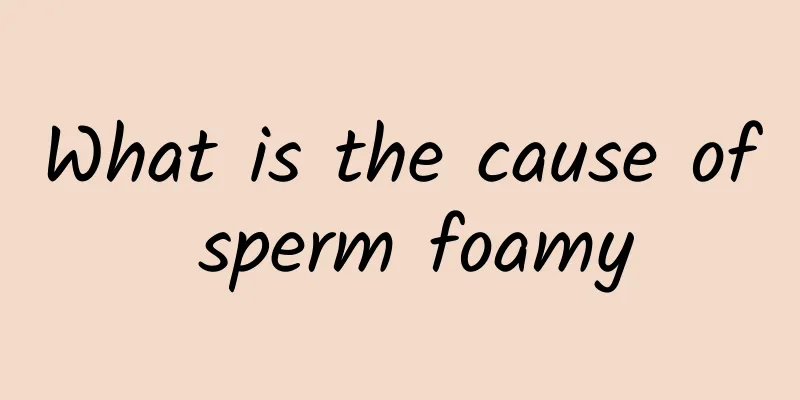What is the cause of sperm foamy

|
Sperm is an important substance for male reproduction. Whether it is abnormal or not directly determines male fertility. Sperm is generally in liquid form, and everyone should be familiar with its shape. However, some men have foam in their sperm after ejaculation. Such an abnormality is definitely very worrying, and they are worried that there is a problem with their sperm. So, what is the matter with sperm foam? Let's take a look at the reasons for sperm foam. It may be caused by prostatitis Causes Only a few patients have an acute history, and most of them present with chronic, recurrent symptoms. The main pathogenic factors of type I and type II prostatitis are pathogenic infection, mainly Escherichia coli, Klebsiella, Proteus and Pseudomonas aeruginosa. Pathogens invade the prostate with urine, causing infection. Pathological anatomy confirms that prostatitis lesions are generally limited to the peripheral zone, where the glandular duct opens in the posterior urethra in the opposite direction of the vertical line of urine flow, which is easy to cause urine reflux, while the glandular ducts in the central zone and transitional zone are consistent with the direction of urine flow, and are not easy to be infected. The prostate has as many as 15 to 30 ducts opening on both sides of the seminal colliculus, and the prostate epithelium has a strong secretory function. The gland is small but the secretory function is strong, and the ducts are narrow, which causes the prostate to be compressed and blocked under the influence of various factors, which can easily cause congestion and secretion accumulation, thus creating conditions for infection. This is also the histological basis for the easy recurrence of prostatitis. Excessive sexual activity, excessive masturbation, long-term sitting, riding a bicycle, riding a horse, alcoholism, excessive spicy food, colds, etc. can all become its inducing factors. The pathogenesis of type III prostatitis is unknown, and its etiology is very complex and widely debated. Most scholars believe that its main causes may be pathogen infection, urination dysfunction, psychological factors, neuroendocrine factors, abnormal immune response, oxidative stress theory, lower urinary tract epithelial dysfunction, etc. Type IV prostatitis lacks research on its related pathogenesis, and may have some of the same causes and mechanisms as type III. Urine reflux in the prostate may be of great significance to the occurrence of various types of prostatitis. Recent studies have found that uric acid in urine not only stimulates the prostate, but can also precipitate into stones, block the gland ducts, and serve as a shelter for bacteria. These findings can explain that prostatitis syndrome is actually a common manifestation of multiple diseases, and the clinical manifestations are complex and varied, which can produce various complications or resolve on their own. Clinical manifestations Type I prostatitis often develops suddenly, with symptoms such as chills, fever, fatigue, and other systemic symptoms, accompanied by pain in the perineum and pubic area, frequent urination, urgency, rectal irritation, and even acute urinary retention. The clinical symptoms of type II and type III prostatitis are similar, mostly with pain and abnormal urination. Regardless of the type of chronic prostatitis, similar clinical symptoms can be manifested, collectively referred to as prostatitis syndrome, including pelvic and sacral pain, abnormal urination and sexual dysfunction. Pelvic and sacral pain is extremely complex. The pain is generally located above the pubic bone, lumbosacral region and perineum. Radiating pain can manifest as pain in the urethra, spermatic cord, testicles, groin, and inner side of the abdomen. It radiates to the abdomen and resembles acute abdominal pain. It radiates along the urinary tract and resembles renal colic, which often leads to misdiagnosis. Abnormal urination is manifested as frequent urination, urgent urination, painful urination, sluggish urination, bifurcated urine stream, dripping after urination, increased frequency of nocturia, and milky white secretions from the urethra after urination or during defecation. Occasionally, sexual dysfunction may occur, including decreased libido, premature ejaculation, painful ejaculation, weak erections, and impotence. Type IV prostatitis has no clinical symptoms and evidence of inflammation is only found during prostate examinations. |
<<: What causes blisters on the testicles?
>>: Endocrine disorders in boys during puberty
Recommend
What is the disease of urinary retention after circumcision?
Because excessive foreskin will bring a lot of in...
What is the reason for the small bump on the glans that doesn’t hurt or itch?
With the development of today's society, male...
What are the dangers of excessive foreskin?
Phimosis can be detected in young boys. Both chil...
How to eat raw almonds: it is safer to eat raw almonds like this
Raw almonds are bitter almonds. There are two typ...
How many sperm does a man have in his lifetime? This is the determining factor!
Men in modern society often smoke and drink, and ...
What to do if your skin is allergic and dry? Four tips to stay away from dryness and allergies
Some people may wonder why dry skin causes allerg...
Contraception with external ejaculation
The best method of contraception is to use condom...
Pictures after circumcision surgery
Prepuce is a serious male disease. Because it is ...
What are the symptoms of a man with a weak yin constitution?
High stress in life, too much work and even irreg...
How to tell if your husband is infected with yeast
We all know that there is a certain relationship ...
Korean minimally invasive phimosis surgery
As for the symptom of foreskin, I think everyone ...
Why do men have a short sex time?
Although our living standard is good now and we d...
What is the reason for bitter mouth and thick white tongue coating when waking up in the morning?
From the perspective of traditional Chinese medic...
How long does it take for a man to ejaculate?
Some male friends are influenced by some TV shows...
What are the reasons for men's bloated abdomen?
When it comes to men's bloated abdomen, every...









